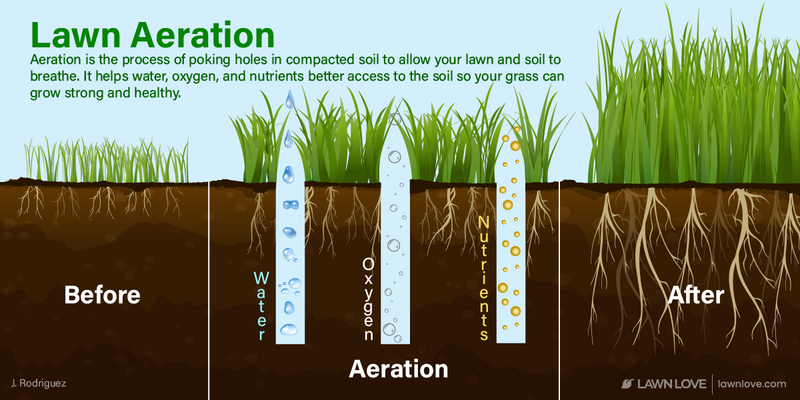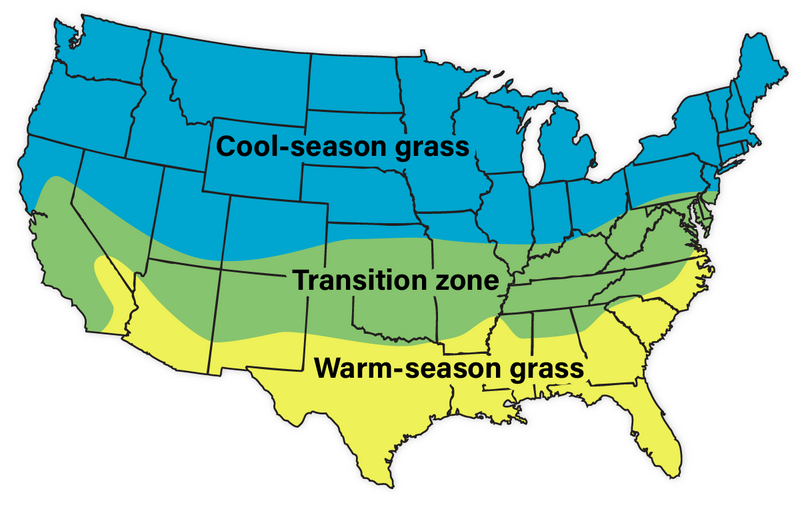
If you’ve ever had a facial, you know how fantastic your skin feels afterward — clean, fresh, and smooth. Well, in the lawn care world, aeration is like a facial for your yard. Aerating your lawn reduces soil compaction to give struggling roots the nutrients they need to grow long and strong, which makes for healthier, greener grass.
What is aeration

Aeration, also known as aerification, is the process of perforating your lawn (dotting it with small holes) to increase the flow of oxygen, water, and nutrients to plant roots. It’s like a three-hole punch for your yard.
Aeration alleviates soil compaction, prevents excessive thatch buildup, and loosens soil so that roots can dig deeper and grow more densely.
A regular aeration schedule will keep your grass healthy, green, and growing vigorously.
What’s wrong with soil compaction?

Compacted soil prevents water and nutrients from penetrating the surface, which means that roots cannot get the water, nutrients, and space they need to grow. In compacted soil, grass roots become malformed and grow very shallow. Over time, grass becomes discolored, develops diseases, thins out, and dies.
Causes of compaction
Your soil can be compacted by:
- Everyday foot traffic
- Construction
- Children and pets at play
- Weather events like strong rainstorms
Soils heavy in clay content are more likely to be compacted than sandier soils.
Harmful effects of compaction
Compaction harms the health of both your lawn and your local ecosystems. It increases the risk of:
- Rainwater puddles and ponding: Compacted soil prevents water from draining into the ground during rainstorms, causing puddles to form in lower areas of your lawn.
- Lawn diseases: Roots are more susceptible to diseases like red thread and rust when nutrients are unavailable and they are under stress.
- Erosion and water runoff: Stormwater easily picks up sediment and pollutants like fertilizer, herbicide, and pesticide from compacted lawns, which means you lose money on lawn supplements and never see the results. Plus, since water cannot drain into the soil, it flows directly into waterways, which causes environmental stress and harms aquatic ecosystems.
Compaction also reduces soil fertility. Lawns with compacted soil require more fertilizer, watering, and seeding than healthy lawns.
Signs your lawn needs aeration

If your grass isn’t filling your lawn like it used to, or if it has lost its rich green color, your soil may be compacted and in need of aeration.
Your lawn may need aeration if:
- Your lawn surface feels spongy and dries out easily.
- Soil feels hard to the touch.
- Grass is thinning or developing diseases like brown patch.
- Your lawn isn’t draining properly during rainstorms (water is forming puddles instead of being absorbed by the soil).
- Your lawn was laid from sod: If sod was laid over compacted soil and the soils were not mixed, roots won’t grow into the ground beneath the sod. Aeration breaks up the layering and mixes the soils to encourage root growth.
- Your house has been newly built: Construction work can strip away topsoil and compact the layer underneath.
- Your lawn gets heavy foot traffic or is a sports area.
- Kids and pets frequently play in your yard.
Benefits of lawn aeration
Aeration boasts a host of benefits for your lawn and local ecosystems.
Aeration …
- Improves grass health and root growth: Roots spread out, strengthen, and grow more densely and vigorously.
- Increases curb appeal: Your grass will have greener, denser foliage.
- Reduces runoff: Permeable soil encourages stormwater to percolate into the ground, instead of rushing into waterways and contaminating the aquatic environment.
- Reduces erosion: Thick grass with a strong, dense root system decreases the potential for erosion.
- Decreases disease susceptibility: Access to oxygen and nutrients increases your grass’s disease resistance.
- Cuts down on dethatching needs: Aeration promotes better drainage and stimulates microbial activity to help decompose thatch, so you won’t have to use a dethatcher or power rake as frequently.
- Increases drought tolerance: With longer, denser roots, your grass can handle dry spells better.
- Saves water: With more permeable soil, you won’t have to water your lawn as frequently or as deeply.
- Controls weeds: Denser, healthy grass will prevent and outcompete weeds.
- Cuts down on fertilizer needs: Nitrogen and potassium deficiencies are common in grasses growing in compacted soil, and these deficiencies lead to the need for additional fertilizer. Aeration helps grasses naturally get the nutrients they need.
- Increases the population of beneficial organisms: Earthworms, soil insects, aerobic bacteria, and fungi thrive in porous, oxygen-rich soil. Once your soil is aerated, they’ll quickly return and help maintain soil health.
- Helps winterize your lawn and prepare it for spring success: Fertilization is more effective when combined with aeration. Aeration increases your lawn’s ability to absorb nutrients, which maximizes spring greening.
When to aerate your lawn

To ensure that your grass quickly recovers and fills the holes in your lawn, you’ll want to aerate during your region’s growing season.
- For cool-season grass lawns (in the northern two-thirds of the U.S., with grasses like Kentucky bluegrass and tall fescue), fall is the ideal time to aerate. While cool-season lawns can be aerated in either early spring or early fall, fall aeration is preferred. Most weeds are not actively germinating in fall, so they’re less likely to sprout in the holes.
- For warm-season lawns (in the southern parts of the U.S., with grasses like Zoysia and bermudagrass), aerate in late spring or early summer for swift grass recovery. To avoid lawn stress, be sure not to aerate at the height of summer heat.
If you’re living in the Transition Zone (the middle slice of the country extending from California to Virginia) or want specific advice for aerating in your region, it’s a good idea to contact your local extension office.
Methods of aeration

You can aerate your lawn using cores, spikes, blades, or liquid.
Core aeration is the most popular and effective method of aeration for homeowners and lawn professionals. It removes cores of soil, rather than just tamping the soil down deeper into the ground or making cuts in the ground. For some agricultural experts, core aeration is the only “real” type of aeration.
- Core aeration: Core aerators (also known as plug aerators) have hollow tines that stick into the ground and remove small plugs of soil. These plugs are then deposited on the surface of the lawn to act as top dressing.
- With core aeration, your lawn becomes freckled with air holes: Cores of soil 2- to 4-inches deep are removed 2 to 3 inches apart from each other.
- Manual core aerators work well for smaller areas, but most homeowners choose a wheeled walk-behind aerator (similar in appearance to a lawn mower) for convenience. You can rent one from your local garden center or home improvement store.
- Spike aeration: Spike aeration is similar to core aeration, but instead of hollow tines removing soil plugs, metal spikes push soil deeper into the ground.
- Some homeowners walk over their lawns using spiked aeration sandals, which are inexpensive and easy to use in small areas. A rolling spike aerator is another option that won’t break the bank.
- However, spike aeration is not the most effective aeration option. Spikes force your soil to bunch up around the sides of the hole, whereas core aeration gives your soil more space to spread.
- Spike aeration promotes grass growth in the short term because holes give roots an immediate dose of oxygen. In the long term, though, spike aeration increases compaction. If you’re looking for a lasting solution, you’ll want to go with core aeration.
- Blade aeration: Blade aeration, also known as slice aeration, uses rotating vertical blades to create slices in your lawn. Like spike aeration, it doesn’t remove any soil from the lawn. However, it also won’t compact the soil like spike aeration is prone to do. It cuts grooves in the soil to give roots better access to nutrients.
- Blade aeration isn’t typically considered true aeration because it doesn’t deeply perforate your lawn. However, it does prepare your yard well for overseeding.
- Liquid aeration: Spraying your lawn with a soap-like solution and letting it break down compacted soil for you sounds like a dream. Unfortunately, it’s more fantasy than reality.
- Liquid aeration solution is designed to loosen the soil, reopening pores and letting nutrients enter.
- While you may see some mild results eventually (if your lawn is only slightly compacted), it’s nowhere near as effective as core aeration. Plus, buying solution for reapplications can put a dent in your budget.
FAQs
Generally, aerating annually is the way to go. However, your soil type determines the right routine for you.
—If you have sandy soil with few drainage issues, you’ll only need to aerate every two or three years.
—If you have heavy clay soil or if your lawn is used frequently for play or sports, it’s a good idea to aerate every year or even twice a year.
To aerate with confidence, call your local extension office for specific pointers about aerating in your region.
Renting a gas-powered, walk-behind aerator (the most popular choice for homeowners) costs approximately $65 for four hours or $100 for a full day. A manual core aerator runs around $30 to $125, depending on its quality and the number of prongs it has.
Yes. It’s a fantastic idea to spread compost, fertilize, and overseed your lawn directly after aerating to increase grass density. For a more even lawn look, wait a month until holes have healed and then overseed.
Giving aeration the thumbs up
If you’re ready to jump on the aeration train and give your lawn the nutrition boost it’s craving, aeration is easy to DIY with a rented core aerator. Or you can call in a local lawn care pro to aerate your lawn while you enjoy getting your own refreshing facial.
Main Photo Credit: allispossible.org.uk | Flickr | CC BY 2.0